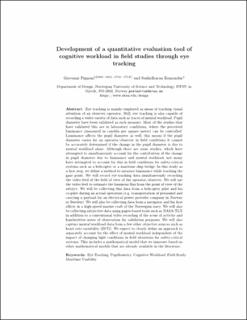| dc.contributor.author | Pignoni, Giovanni | |
| dc.contributor.author | Komandur, Sashidharan | |
| dc.date.accessioned | 2021-01-27T07:20:08Z | |
| dc.date.available | 2021-01-27T07:20:08Z | |
| dc.date.created | 2019-09-13T12:03:18Z | |
| dc.date.issued | 2019 | |
| dc.identifier.issn | 0302-9743 | |
| dc.identifier.uri | https://hdl.handle.net/11250/2724877 | |
| dc.description.abstract | Eye tracking is mainly employed as mean of tracking visual attention of an observer/operator. Still, eye tracking is also capable of recording a wider variety of data such as traces of mental workload. Pupil diameter have been validated as such measure. Most of the studies that have validated this are in laboratory conditions, where the perceived luminance (measured in candela per square meter) can be controlled. Luminance affects the pupil diameter as well; this means if the pupil diameter varies for an operator/observer in field conditions it cannot be accurately determined if the change in the pupil diameter is due to mental workload alone. Although there are some studies, which have attempted to simultaneously account for the contribution of the change in pupil diameter due to luminance and mental workload, not many have attempted to account for this in field conditions for safety-critical systems such as a helicopter or a maritime ship bridge. In this study as a first step, we define a method to measure luminance while tracking the gaze point. We will record eye-tracking data simultaneously recording the video feed of the field of view of the operator/observer. We will use the video feed to estimate the luminous flux from the point of view of the subject. We will be collecting this data from a helicopter pilot and his co-pilot during an actual operation (e.g. transportation of personnel and carrying a payload for an electrical power provider company in Norway or Sweden). We will also be collecting data from a navigator and his first officer in a high-speed marine craft of the Norwegian navy. We will also be collecting subjective data using paper-based tools such as NASA-TLX in addition to a conventional video recording of the scene of activity and handwritten notes of observation for validation purposes. We will also capture mental workload data from a few other objective sources such as heart rate variability (ECG). We expect to clearly define an approach to separately account for the effect of mental workload independent of the impact of changing light conditions in field situations for safety-critical systems. This includes a mathematical model that we innovate based on other mathematical models that are already available in the literature. | en_US |
| dc.language.iso | eng | en_US |
| dc.publisher | Springer | en_US |
| dc.title | Development of a Quantitative Evaluation Tool of Cognitive Workload in Field Studies Through Eye Tracking. | en_US |
| dc.type | Peer reviewed | en_US |
| dc.type | Journal article | en_US |
| dc.description.version | acceptedVersion | en_US |
| dc.source.volume | 11571 | en_US |
| dc.source.journal | Lecture Notes in Computer Science (LNCS) | en_US |
| dc.identifier.doi | 10.1007/978-3-030-22507-0_9 | |
| dc.identifier.cristin | 1724439 | |
| dc.description.localcode | "This is a post-peer-review, pre-copyedit version of an article. The final authenticated version is available online at: https://doi.org/10.1007/978-3-030-22507-0_9 | en_US |
| cristin.ispublished | true | |
| cristin.fulltext | original | |
| cristin.fulltext | postprint | |
| cristin.fulltext | preprint | |
| cristin.qualitycode | 1 | |
